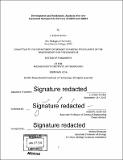| dc.contributor.advisor | Daniel G. Anderson. | en_US |
| dc.contributor.author | Dorkin, J. Robert (Joseph Robert) | en_US |
| dc.contributor.other | Massachusetts Institute of Technology. Department of Biology. | en_US |
| dc.date.accessioned | 2016-06-22T17:50:39Z | |
| dc.date.available | 2016-06-22T17:50:39Z | |
| dc.date.copyright | 2016 | en_US |
| dc.date.issued | 2016 | en_US |
| dc.identifier.uri | http://hdl.handle.net/1721.1/103237 | |
| dc.description | Thesis: Ph. D., Massachusetts Institute of Technology, Department of Biology, 2016. | en_US |
| dc.description | Cataloged from PDF version of thesis. | en_US |
| dc.description | Includes bibliographical references (pages 110-116). | en_US |
| dc.description.abstract | A limited number of siRNA and mRNA based therapeutics have been developed largely due to the difficulties of efficaciously delivering RNA to cells in vivo. Liposomal nanoparticles (LNPs) have shown some success, but their design is limited by both a lack of information concerning the optimal lipid composition and insufficient data regarding the LNPs' interaction with their environment. Further elucidation of the physical properties of LNPs as well as their mechanisms of action will improve future development of RNA therapeutics. Using a combinatorial lipid library, we identified four design criteria that are required for efficacious LNP delivery of siRNA: the presence of a tertiary amine, having lipid tails that are 13 carbons long, having three or more lipid tails, and having an LNP pKa of 5.4 or more. LNPs meeting all four of these conditions demonstrated 100% probability of efficaciously delivering siRNA to hepatocytes in vivo. While numerous LNPs have been developed for siRNA delivery, few have been developed for mRNA delivery. Utilizing LNPs optimized for siRNA to deliver mRNA instead could rapidly reduce development time and cost for mRNA therapeutics. Here, we demonstrate that the relative efficacy of 48 different ionizable lipids were comparable for both siRNA and mRNA delivery, but that several formulation parameters must be modified for optimal mRNA delivery. These include a lower molar percent of the ionizable lipid, having a higher total lipid to RNA weight ratio, and containing conical phospholipids instead of cylindrical phospholipids. Using LNPs to deliver RNA to cells other than hepatocytes has proven difficult. By incorporating a positive surface charge on the LNPs we redirected liver targeted liposomes to lung endothelial cells. Examination of the plasma proteins bound to the LNPs revealed apolipoprotein (Apo) B and ApoE attached to the hepatocellular targeted LNPs, with serum albumin and fibrinogen were bound to the lung targeted LNPs, and ApoAl found on both types of LNPs. Subsequent in vitro experiments demonstrated that VLDL and HDL are important for hepatocellular and lung endothelial cell delivery, respectively. Plasma proteins function by improving the cellular uptake of the LNPs, as we demonstrated that ApoE is essential for hepatocellular uptake via macropinocytosis. | en_US |
| dc.description.statementofresponsibility | by J. Robert Dorkin. | en_US |
| dc.format.extent | 132 pages | en_US |
| dc.language.iso | eng | en_US |
| dc.publisher | Massachusetts Institute of Technology | en_US |
| dc.rights | M.I.T. theses are protected by copyright. They may be viewed from this source for any purpose, but reproduction or distribution in any format is prohibited without written permission. See provided URL for inquiries about permission. | en_US |
| dc.rights.uri | http://dspace.mit.edu/handle/1721.1/7582 | en_US |
| dc.subject | Biology. | en_US |
| dc.title | Development and mechanistic analysis of in vivo liposomal nanoparticle delivery of siRNA and mRNA | en_US |
| dc.type | Thesis | en_US |
| dc.description.degree | Ph. D. | en_US |
| dc.contributor.department | Massachusetts Institute of Technology. Department of Biology | |
| dc.identifier.oclc | 951608088 | en_US |
